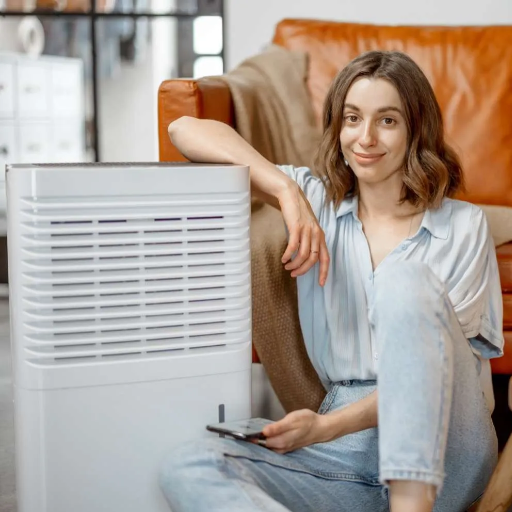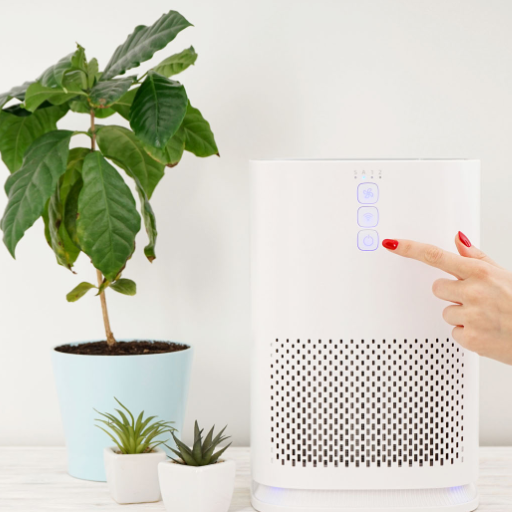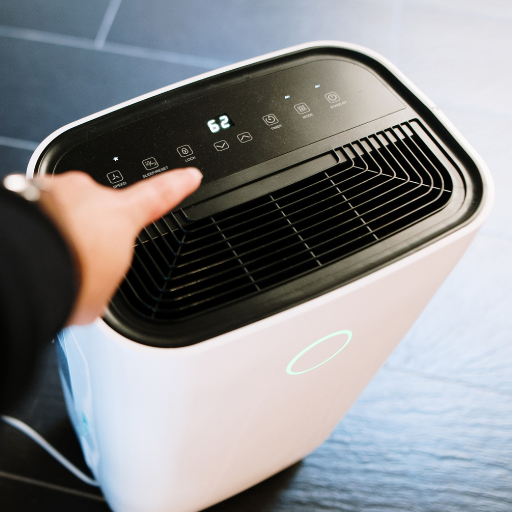Countless people globally are affected by allergies, which cause discomfort and decreased quality of life. Therefore, managing allergens in indoor air is crucial for reducing allergy symptoms, which calls for selecting an appropriate device. The three alternatives include air cleaners, humidifiers, and dehumidifiers, which serve various purposes, but it is essential to distinguish between them to make an informed choice. In this section, we provide an exhaustive comparison of these gadgets based on their impact on indoor air quality that can aid allergy relief. To do this, this guide will define the uses of air purifiers, humidifiers, and dehumidifiers, respectively, along with their benefits and limitations to assist readers in making better decisions regarding the most suitable option for treating their allergies.
What is the connection between humidity and allergies?

Humidity significantly affects allergen levels and behavioral patterns within a house. The presence of mold, mites, and increased amounts of air pollutants, which are common allergens, is facilitated by high humidity levels (above 50%). On the other hand, extremely low humidity conditions (less than 30%) make nasal passages and respiratory linings dry, exposing persons to more irritants and allergens. Maintaining indoor humidity levels between 30% – 50% is essential as this will help minimize allergens and thus improve comfort among allergy victims.
How does high humidity affect allergens in your home?
Excessive moisture supports the growth and survival of allergens like mold and dust mites. For instance, damp spaces such as walls, ceilings, and carpets are conducive to the thriving of molds, which release spores that can exacerbate breathing problems and cause allergies. On the other hand, dust mites, tiny organisms found in beddings, furniture, and rugs, prefer a more humid environment, enabling them to absorb water from their surroundings. Moreover, increased humidity levels make removing sticky airborne particles like pollen or pet dander more complex, thus contributing to poor air quality. Properly handling indoor humidity by installing air conditioners or dehumidifiers and having proper ventilation is vital in mitigating these risks and reducing exposure to allergens.
What is the ideal relative humidity for allergy sufferers?
The most appropriate relative moisture level for allergy sufferers is between 30% and 50%. This makes an environment that discourages the growth of allergens such as mildew and dust mites, which thrive well in higher humidity levels. Besides, it prevents air from going too dry, thus causing respiratory irritations that may worsen allergic reactions. Correctly controlling and monitoring indoor moisture through dehumidifiers, air conditioners, or hygrometers is necessary to maintain these optimum conditions while improving general air quality.
How do dehumidifiers help with allergies?

High humidity levels encourage the growth of common allergens, such as mold, mildew, and even dust mites. Dehumidification prevents this by ensuring the indoor humidity level is optimum. Thus, it improves air conditions and reduces the chances of an allergic attack on someone prone to such allergens, especially during high humidity periods. This makes it possible to alleviate symptoms for those with humidifier-causing allergies.
Can dehumidifiers reduce dust mites and mold growth?
Dehumidifiers can control dust mites as well as reduce mold formation. The relative humidity (RH) should not exceed 50% to stop dust mite proliferation, whereas increased moisture content above 60% RH results in molds growing inside these affected spaces. Most homes have recommended indoor relative humidity that should be maintained at 30-50%; this is achievable by using dehumidifiers, making the indoor environment less conducive for mold and dust mite survival and multiplication. Consequently, properly using a dehumidifier enhances air cleanliness while minimizing health hazards associated with allergens or molds that cause respiratory problems.
What types of allergies can a dehumidifier help with?
You can use a dehumidifier to stop mold, dust mites, and mildew allergic reactions. It prevents the multiplication of these common allergens in moist atmospheres. They tend to flourish by controlling indoor humidity within the optimal range of 30-50%. This will help with symptoms such as sneezing, blocked nose, and watery eyes due to these triggers. Besides, it assists in maintaining better air quality while promoting respiratory health and comfort by controlling humidity.
How does a dehumidifier improve indoor air quality?
A dehumidifier advances the quality of indoor air by monitoring and minimizing excess moisture that hinders allergies like mold, dust mites, or mildew from spreading. A dehumidifier maintains moisture contents at about 30-50%, thus reducing conditions on which these allergens thrive, reducing their impact on respiratory health. Furthermore, reduced humidity inhibits bacterial growth and other airborne irritants, making the air cleaner and healthier. Also, removing damp odors after water damage facilitates a more pleasant indoor environment; drier conditions decrease further destruction that could occur to walls or furniture, thereby improving the overall indoor atmosphere.
Dehumidifier vs. air purifier: Which is better for allergies?

The choice between a dehumidifier and an air purifier for allergies depends on the first agents in your environment. Dehumidifiers are very effective in reducing humidity levels that minimize the growth of mold, mildew, and dust mites since they breed in damp conditions and are some of the most common allergens in any household. An air purifier, as opposed to this, operates by sifting all flying objects, such as pollen, pet dander, and dust, therefore directly dealing with allergens suspended therein. At the same time, a dehumidifier helps reduce moisture levels within a room. Individuals with developed sensitivity towards airborne allergy triggers should choose air purifiers rather than humidifiers. However, using both can be more effective for those who live in regions with high humidity levels because such appliances help deal with two types of things that cause allergies: moisture-related ones and those transmitted through air.
How do air purifiers and dehumidifiers differ in alleviating allergy symptoms?
Distinct yet complementary, air purifiers and dehumidifiers alleviate allergy symptoms. The air is bettered by catching airborne particles such as pollen, dust mites, mold spores, and pet dander using HEPA filters or ionizers. This directly lowers allergens in the air, making them ideal for people with respiratory sensitivities. On the contrary, dehumidifiers maintain the level of moisture in a room usually below 50%, thus discouraging the growth of molds, dust mites, and other allergy-causing agents often found in moist surroundings. Unlike air purifiers aimed at removing airborne contaminants, dehumidifiers deal with root causes that encourage the accumulation of allergens. Typically, when these two are combined, it results in the most effective approach to managing allergies, mainly where humid or damp conditions exist.
Can you use both a dehumidifier and an air purifier together?
Combining a dehumidifier and an air purifier is possible and highly practical in improving indoor air quality. These two devices function independently but are mutually beneficial in managing different aspects relating to air purity. A dehumidifier helps reduce air moisture levels, discouraging mold growth, mildew, and allergens such as dust mites, which thrive best under humid conditions. However, an air purifier takes these pollutants like dust, pollen, smoke, and animal dander from the breathing space. Both may be operated simultaneously to provide a conducive indoor environment with minimal allergens and airborne particles while maintaining suitable humidity levels. For optimal results, they should be placed strategically within the same room without blocking airflow; their capacities must also match the size of the room.
Which device is more effective for specific types of allergies?
Regarding specific allergies, air purifiers are usually more effective in combating allergens such as pollen, pet dander, and dust since they actively strain these particles from the air. On the contrary, humidifiers are better suited to help alleviate symptoms brought about by dry indoor air, like irritated sinuses and throat discomfort. An individual with airborne-triggered allergies should use an air purifier instead of a humidifier. However, a humidifier can also be used alongside an air purifier to prevent dryness that may worsen some symptoms.
Are humidifiers or dehumidifiers better for allergy relief?

Dehumidifiers eliminate excess moisture from the atmosphere in high humidity, which leads to the growth of allergens such as mildew, mold, or dust mites. On the other hand, humidifiers become beneficial when indoor air is too dry, which can irritate the respiratory system and exacerbate allergy symptoms. One must take into account specific environmental conditions and triggers for each case. To optimally manage allergies, it is recommended that indoor humidity levels be kept between 30-50%.
When should you use a humidifier instead of a dehumidifier for allergies?
During winter or in arid climates, allergies can be relieved using a humidifier instead of a dehumidifier when the indoor air is arid. Dry air irritates the respiratory system, causing scratchy throat, dried nasal passages, and greater sensitivity to allergens. Humidity added to the air by a humidifier helps with these conditions, moisturizes mucous membranes, and mitigates dryness-related discomfort. However, monitoring and maintaining humidity at optimal levels between 30-50% is essential because excess moisture can develop allergens such as molds and dust mites, increasing allergy symptoms.
How do humidifiers and dehumidifiers affect different allergens?
Humidity regulators like humidifiers and dehumidifiers handle allergens differently by controlling indoor humidity levels. From my inquiry, I have found that humidifiers can be helpful for respiratory irritation caused by dry air. Still, excessive use might result in the proliferation of mold and dust mites, both common allergens. On the other hand, dehumidifiers remove excessive moisture, making environments unfavorable for mold and dust mite growth. The balance between reducing allergens and maintaining comfortable indoor air quality involves keeping humidity within an appropriate 30-50% range.
Can using the wrong device worsen allergy symptoms?
Correct device use can worsen allergies. A good example is when one uses humidifiers excessively, which leads to too much moisture and gives a perfect condition for the growth of common allergens such as mold and dust mites. Dehumidifiers, on the other hand, if set very low in humidity levels, can cause nasal passages and respiratory tracts to dry up, leading to irritation and more susceptibility to allergens. Lastly, air purifier units with substandard filters may also result in distribution rather than elimination of allergens. Consequently, we must select the right appliance and retain ideal indoor moisture at 30-50% for allergy control and health promotion.
How do you choose the right dehumidifier for allergy relief?

Begin by considering the size of the area where you want to install a dehumidifier for allergy relief. This is important as it will help you know how much water your dehumidifier should handle daily, depending on your room’s square footage and humidity level. Therefore, choose one with an adjustable humidistat to regulate indoor humidity within the 30-50% range. Moreover, look for features such as washable or HEPA filters that can effectively capture airborne allergens. You must also consider energy efficiency ratings and sound levels while using one continuously and comfortably. Furthermore, regular maintenance involving cleaning the unit and emptying its water reservoir is critical to consistently achieving optimum performance and avoiding mold growing.
What features should you look for in a dehumidifier for allergies?
To pick a dehumidifier for allergies, always choose one with a large capacity that can fit into your area to ensure efficiency in removing moisture. Consider models with either a HEPA filter or an antimicrobial filter that can effectively capture allergens such as dust mites, mold spores, and pollen. Adjustable humidity controls and built-in humidistats help maintain the desired indoor moisture levels by minimizing conditions that promote allergen growth. For energy-efficient operation and reduced utility costs, seek Energy Star-certified appliances. Additionally, continuous drainage facilities minimize maintenance requirements, while silent operations mode is vital for comfort in living or sleeping areas. Regular replacement of filters is essential to maintain performance and air quality at optimal levels.
How do you determine the appropriate size and capacity for your home?
While choosing the right size and capacity of dehumidifier for your home, I consider the targeted area’s sq. ft coverage and the humidity level. Small-capacity units (20-30 pints) are recommended for spaces up to 1,500 square feet that have minor moisture problems, while medium (30-50 pints) and large capacity ones (50-70 pints) are best suited for larger areas or those with higher moisture content. Additionally, specific circumstances, such as wet basements or bathrooms, may necessitate a unit, which might call for a unit with high capacity. An energy-efficient and effective choice is made by referring to manufacturers’ size guides and confirming performance certifications like Energy Star.
Are there any specific brands recommended for allergy sufferers?
For individuals with allergies, many brands such as Honeywell, Aprilaire, and Coway often top the list because they have a proven track record; moreover, they have advanced filtration systems that guarantee quality air purification. On the other hand, Honeywell’s dehumidifiers come with superior air filters capable of reducing airborne allergens like mold spores and dust particles. Similarly, several Aprilaire models feature modern humidity controls that are meant specifically for allergy sufferers’ best comfort levels should be maintained at least. Moreover, Coway offers small yet efficient gadgets, including HEPA filters that can trap even tiny bits to ensure cleaner air comes from them. These can be trusted due to their reliability and effectiveness in building an allergy-friendly environment.
Tips for using a dehumidifier to manage allergies

One can utilize several key practices to effectively use a dehumidifier for allergy management. First, you should maintain the humidity level within 30% – 50%; this will help prevent the growth of mold and dust mites. It is essential to ensure that the size of the dehumidifier is appropriate for your room; undersized units may not work efficiently. Always ensure that the water reservoir and filter are cleaned regularly to avoid bacteria or mold from forming. Keep it in high humidity, like bathrooms or basements, and provide enough circulation around it. Lastly, you could combine it with other allergy-reducing measures, such as an air purifier with a HEPA filter to maximize results.
Where should you place a dehumidifier for maximum effectiveness?
For a dehumidifier to work effectively, the higher humidity areas in basements, crawlspaces, kitchens, and bathrooms are best. Put the machine at a central position inside the space, some 6-12 inches away from walls or furniture that might impede airflow. It should not be placed near dust, dirt, or anything that may obstruct its inlet for air or outlet for air vents. In the case of multi-story buildings, lower levels are given priority since moisture usually accumulates there. If possible, one can close windows and doors where you want to dehumidify to increase the impact of your dehumidifying efforts. In addition, one can use a hygrometer to monitor humidity level changes and adjust placements or settings accordingly.
How often should you run a dehumidifier to control allergies?
The regularity of running a dehumidifier for allergies relies on how high or low the humidity is in your house. I seek to have indoor relative humidity within 30-50%. Finally, I usually make sure my dehumidifier is working daily when it gets rainy or during those times when we experience a lot of heat with much dampness just to avoid any possibilities of mold developing due to wetness around me, dust mites and other allergens being my key concern at all times. It is easier because I can use hygrometers that let me know when humidity changes, altering my use patterns to maintain a comfortable living environment that harbors few allergens.
What maintenance is required to keep your dehumidifier allergy-friendly?
For your dehumidifier to be allergy-friendly, regular maintenance is required. Regularly clean air filters, either by the manufacturer’s advice or every two weeks, as this will clog and circulate allergens. Ensure that you empty and sanitize the water tank when it is filled up with water so that bacteria or mold do not grow–some droplets of mild soap or vinegar mixed with water can do this. Check coils regularly to see any dirt particles or dust so they are cleaned for best functioning. In addition, periodically examine the unit’s vents and overall functionality to fix any blockages and malfunctioning promptly. Thus, consistent care keeps indoor air fresher and lengthens the dehumidifier’s life span.
References
Frequently Asked Questions (FAQ)
Q: How do dehumidifiers help with allergies?
A: Dehumidifiers can help with allergies by reducing excess moisture from the air, which creates an unfavorable environment for allergens like mold, dust mites, and mildew. By lowering the humidity level in your home, dehumidifiers can improve air quality and potentially alleviate allergy and asthma symptoms.
Q: What’s the difference between a humidifier and a dehumidifier for allergy relief?
A: While both devices affect air moisture, they serve opposite purposes. Dehumidifiers remove moisture from the air, helping to reduce mold and dust mite growth in humid environments. Humidifiers, on the other hand, add moisture to the air, which can be beneficial in dry climates or during winter when indoor air becomes dry. The choice between a humidifier vs. a dehumidifier depends on your specific environment and allergy triggers.
Q: How does humidity affect indoor allergies?
A: Humidity plays a crucial role in indoor allergies. High humidity levels (above 50 percent) can promote the growth of mold, mildew, and dust mites, which are common allergens. Conversely, very low humidity can irritate nasal passages and worsen allergy symptoms. Maintaining optimal temperature and humidity levels (between 30-50%) can help reduce allergens and improve overall air quality in your home.
Q: Can a dehumidifier help with asthma symptoms?
A: Yes, a dehumidifier can help with asthma symptoms. By reducing excess moisture in the air, dehumidifiers create an environment less conducive to mold, dust mites, and other allergens that can trigger asthma attacks. The American Academy of Allergy, Asthma, and Immunology recommends maintaining indoor humidity levels between 30% and 50% to help manage asthma symptoms.
Q: Are air purifiers or dehumidifiers better for removing allergens?
A: Both air purifiers and dehumidifiers can benefit allergy relief, but they work differently. Air purifiers, especially those with HEPA filters, are excellent at removing airborne allergens like pollen, pet dander, and some mold spores. Dehumidifiers, however, reduce moisture in the air to create an environment that’s less hospitable for allergens like mold and dust mites. For comprehensive allergy relief, using both devices can be beneficial.
Q: Where is the best place to use a dehumidifier for allergy relief?
A: Dehumidifiers are most effective in damp or humid areas of your home. Basements are familiar for dehumidifier use, as they’re often prone to excess moisture. Other beneficial areas include bathrooms, laundry rooms, or any space that feels stuffy or has visible signs of mold or mildew growth.
Q: How do I know if I need a dehumidifier or a humidifier for my allergies?
A: To determine whether you need a dehumidifier or a humidifier, consider your home’s environment and specific allergy triggers. A dehumidifier may be beneficial if your home feels damp, has a musty odor, or you see signs of mold or mildew. If the air in your home feels dry, causing irritated sinuses or a stuffy nose, a humidifier might help. You can also use a hygrometer to measure your home’s humidity level; if it’s consistently above 50%, a dehumidifier could help, while levels below 30% might call for a humidifier.



